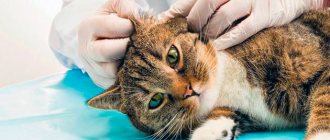When there is a cat and a small child in the house, problems associated with their relationship often arise. It is not uncommon for a cat to hiss at a child for no apparent reason. Why she does this, you can answer after carefully observing her. - After what actions of the child does the cat hiss. It is only outwardly that it seems that she is doing it just like that. She definitely has her reasons to behave aggressively.
© shutterstock
A cat may hiss aggressively for several reasons.:
- jealousy,
- fear,
- protection of the territory.
Let's look at each of them.
Territory threat
Cats perceive your home as their own, safe territory, where they are the rightful owner. If a small “stranger” suddenly appears in its possession, the animal experiences stress and perceives the child as a threat to its safety. In some cases, the cat will try to avoid the “alien”, and in others it will begin to take action to protect its space.
Trying to get attention
What to do if a cat chews wires?
The cat perceives a lack of attention from the owner as a personal insult. She begins to raise her voice. Its timbre depends on what she is trying to say. Initially, it will seem like a newly born baby is crying.
Read also: Why is a child afraid of the dark?
If this does not help, the crying develops into a loud screeching siren, upon hearing which the owner will rush as fast as she can to the screamer in fear that something irreparable has happened. And he will be very surprised when he meets the calm, “I have nothing to do with it here” look of his pet.
Cats have other ways to attract attention. For example, throwing things off tables and cupboards, scratching doors, trying to open a closed door with a run. A reminder that the pet is hungry can be an empty bowl at the owner’s feet and the heart-rending cries of a hungry pet.
Treatment of complications after a bite
Regardless of the size of the wound, the baby should be shown to a traumatologist. The surgeon will carefully examine the wound, clean and treat it, and apply a disinfectant bandage. If vaccination with tetanus toxoid was carried out a long time ago, the child is prescribed a tetanus vaccination. If the bite was inflicted by a stray cat or one whose owner cannot present a document on the animal’s vaccinations, the victim is vaccinated against rabies with anti-rabies serum according to the scheme.
If swelling or redness is observed, topical antibiotics for the cat bite are recommended. They are used in the form of an ointment:
- Gentamicin;
- “Levomekol”;
- Tetracycline;
- Levomycetinova.
In case of inflammation and suppuration of the wound, the doctor makes an incision and carefully cleans the wound surface from the accumulation of fluid and necrotic tissue. It is washed with antiseptics (Chlorhexidine or Miramistin) and cauterized with iodine. Be sure to apply a loose bandage, which should be changed daily. To prevent blood poisoning, treatment of a cat bite is supplemented by oral antibiotics:
- Azithromycin;
- Amoxicillin;
- Gentamicin K.
Attention! If sepsis is suspected, antibiotics should be prescribed by a doctor. He selects the drug based on tests and calculates the dosage individually. Self-medication is fraught with deterioration of the condition and can lead to serious consequences.
During antibiotic treatment, the child should be given probiotics, which help restore intestinal microflora and strengthen the immune system.
To heal, the wound is lubricated with Solcoseryl ointment 2 times a day. It contains components that accelerate tissue regeneration, preventing the formation of scars. Proper nutrition and vitamin complexes will improve the well-being of the little patient and support the body’s defenses.
Hissing is inherent in this breed
In some cases, a cat hisses because it is inherent in its breed. Let's say Siamese hiss due to the inherent behavior of this type of temperament. Some active breeds start to hiss because they don't get enough exercise. These are Abyssinian, Oriental, Cornish Rex and some others. Some furry breeds (Persians) hate it when they wash themselves and immediately start petting them. And there are hairless cats (Egyptian breed) - they hiss constantly, because hissing is part of their conversation, and does not necessarily mean aggression.
What to do if a cat attacks a child?
Safety is the key point in the relationship between a child and a cat, and one that worries parents the most. Cats and people belong to different biological species, so it can be very difficult for them to understand each other, even if we are talking about an adult, not to mention an unintelligent child. Let's try to figure out why a cat bites children and what to do in such cases?
Reasons for a cat attacking a child
If you look on the Internet for recommendations on the topics “why does a cat hiss at a child” or “why does a cat attack a child and bite” on forums, the most common answer is: “the cat takes revenge on the child out of jealousy.” People generally tend to attribute human feelings and emotions to animals, although they are simply incapable of experiencing such multifaceted emotions as jealousy, envy, resentment, etc.
Cats obey instincts, not emotions, although they have a rather gentle and subtle mental organization and can be greatly impressed by events that seem insignificant to us humans.
First, you need to understand one important thing: a cat never attacks without a reason, another thing is that they are not always clear to people. Let's list the main ones.
Baby and cat in the same house
An infant and a cat often worry the baby’s parents not because of the fact of aggression, but because of fears that the pet may harm the child: it will suddenly scratch it, suddenly press it with its body, or suddenly infect it with something by licking the baby’s “milky” mouth. Here we can only advise one thing: watch. Don't startle the cat as soon as it approaches the cradle. It is important to find out her intentions in order to know for sure whether there is danger or whether her fears are far-fetched.
To minimize risks:
- do not leave toys in the baby's cradle if the cat or child is unattended;
- do not leave cookies or bottles of food inside;
- Do not allow your cat to sleep in the crib. But without obvious dissatisfaction. You just need to carefully shift the cat - she will understand that she still can’t sleep there. It is advisable to purchase a comfortable lounger or house; you can put a bottle of lukewarm water inside to attract your pet to a new place and make you forget about the cradle. The house must be placed on an elevation so that it is higher than the cradle;
- Take your cat to the vet to make sure that it is completely healthy and does not pose a danger to the baby.
Is the cat sick?
The cause of “sudden” aggression with mutilation by biting can be triggered if the cat is sick. For example, an otitis media or hematoma can cause an aggressive reaction to your hand when you accidentally touch a cat’s ear or head; a subcutaneous abscess formed on the body or an injury invisible to the eye. If this behavior was not typical “before today,” take the animal to the doctor.
The reason that the cat has become aggressive may also be a disorder of the nervous system - neurosis. This disorder occurs when nerve structures are overstrained, leading to disruption of the physiological activity of the brain. Simply put - stress, obsessive fear, overwork, intoxication, endocrine disorders, vitamin deficiency and infectious diseases. A visit to the doctor is mandatory, because... it will be necessary to conduct a series of studies in order to eliminate the cause of the neurosis and exclude such a dangerous acute infectious disease as rabies.
Not jealousy, but boredom
Often, with the arrival of a child in a family, pets are relegated to the background. They are given less attention, they don’t play with them, don’t talk to them, aren’t allowed into the nursery where adults spend most of their time, or even forget to feed them or clean the toilet. Of course, such changes will not go unnoticed for the cat - the animal will feel abandoned, experience discomfort and may go the “wrong way” in attempts to attract attention.
Hisses at the owner
If the animal is not in pain, no one annoys it, aggression towards the owner may be due to the fact that it was severely punished by him. Even a loud cry is perceived negatively by a cat. She will remember who yelled at her and will hiss at that person. You can forget about the incident, but cats often don’t forget this.
To maintain a good relationship with your pet and peace in the house, you should treat everyone who lives nearby with respect.
You cannot hit cats; they will not forget aggression and will perceive it as a threat, as an attack. And in turn, the animal will behave accordingly - move away from the person, hiss and snort in response.
But a cat can hiss at its owner out of surprise or fear. For example, someone approached her silently, and hissing becomes natural behavior for the pet at such a moment. Just as a black cat scares people, it can also experience fear at some moments.
Rabies in a cat - treatment
Rabies is an incurable disease. There is no effective cure for it. The veterinarian can only euthanize the cat.
Can you get rabies from a cat? The answer is very short - unfortunately, yes. This infection is also fatal to humans. However, a pet does not become infected until about 3 days before the first symptoms appear. That's when the virus appears in his saliva. Therefore, it is very dangerous if a person is bitten by a cat or even licked in a place where there is a small cut on the skin.
Through the eyes of a cat and the eyes of a child
Animal psychologists name three main reasons why small children and cats cannot find a common language: fear, jealousy and defense of territory. Whatever the reason for starting a military campaign, the basis for solving the problem should be love and patience, even if the cat attacked the child for no apparent reason or the child hit the cat, seemingly for no reason. However, it is important to get to the root cause in order to know in which direction to move.
- Fear
Understanding why cats are afraid of children is not that difficult. Babies are noisy, fussy, unpredictable and eccentric creatures. The cat loves peace and quiet, values privacy and respects boundaries when communicating. Not every pet is happy when a stranger wants to pat her behind the ear. What can we say about a child who, despite all the signals given, stubbornly refuses to back down! If a domestic cat bit a child, most likely, before taking extreme measures, she made it clear for a long time and persistently that she did not need close contact: she flattened her ears, bristled her whiskers, sparkled her eyes and beat her tail on the floor. But any patience comes to an end, and the teeth begin to enter.
The baby, having first “become acquainted” with teeth or claws, remembers the lesson for a long time. Now the cat is not a funny soft toy with batteries, but something evil and dangerous, capable of causing pain. In some cases, the child deliberately torments the cat, taking revenge on her for her reluctance to communicate and remembering the bite or scratches. This is the case when fear takes an aggressive form: the best defense is attack. This also includes a defensive reaction when a child hits a cat with a bucket just because it is approaching him. Perhaps the pet is interested in the squeaker or wants affection, but once upon a time a cat scratched the child, and he remembers it very well. In this case, it is important to explain to the child why the cat is attacking. Talk about the pain that the baby causes with careless movements. Be sure to explain that the cat is also a member of the family, that we love it too, since it protects our house from arrogant mice who would certainly take away your candies and toys if it were not for the cat. And she is very brave and strong: “Do you remember how painful it was when she scratched you? Not a single mouse will pass!
- Jealousy
Kids quickly get used to the fact that everyone, from their mother to an unfamiliar aunt from the store, is delighted and touched by them. And then suddenly some cat dared to show her claws! It’s both scary and offensive - we need to show her who’s boss. In turn, a cat, accustomed to attention, feels abandoned when a child appears in the house. This means you need to drive out your competitor. This is the case when a cat in the house and a child can live in peace if adult family members find time to communicate on equal terms with both the baby and the pet. Joint games and natural science “lessons” for the child help: “Look how high the cat can jump! Do you know why she needs a mustache and a tail? Do you know why she has such amazing eyes?” Replacing jealousy with lively curiosity is a great option.
- Territory defense
One of the reasons why a cat hisses at a child is to defend its territory. While the baby spends all the time in the cradle or in the arms of the mother, the cat is calm and does not perceive him as a competitor. But when the child begins to crawl, grab her “prey,” touch bowls and crawl into her favorite house, it’s time to act. The cat begins to educate the baby, showing him that some objects and places are her property.
Often a kitten and a child in the house fight over the baby's toys. Not all children know how to share and not everyone easily agrees to have a cat lie on their bed, take their favorite toys with its teeth and lie on the lap of their beloved mother. In this case, there are two decisions: everything is shared or yours and mine. The first option is simpler: we arrange joint games, under supervision we allow the baby to touch what the cat considers to be its property, teaching it to calmly react to intrusion. The second option: show the child what belongs to the cat and explain that it should never be touched (bowls, toys, bedding, etc.). The difficulty is that it is almost impossible to teach a cat not to react to children’s toys, so it is better to educate from the position of “don’t be greedy.” Universal advice without reference to the reason for the “confrontation”: in order for the baby to change his anger to mercy, shift some of the caring responsibilities to him cat Explain that he is already big and almost completely grown up, that the cat needs his support and care: “let’s pour water for Bead, let’s feed him, let’s brush his hair.” Together you can make a toy for your pet or sew her a warm mattress. The child, feeling strong, responsible and grown-up, perceives the cat as a creature that needs to be protected and protected, and therefore treated with care and attention. In order for the cat to react more calmly to the child, you need to control the baby’s actions. In addition, it is important to provide peace for the cat by installing a house somewhere higher where the child cannot reach. Punishments will make the situation worse, so it is important to be patient when disciplining a mustachioed aggressor without physical force.
Why does a cat bite after being petted?
Have you ever had a cat jump onto your lap and persistently demand a portion of affection, freeze for a few minutes, and then sharply bite the hand stroking them?
There are two explanations here:
- The cat's tolerance threshold has been exceeded
This happens when you ignore the signals that cats give not only with their voice, but also with the “gestures” of their body:
- the cat stopped purring
- does not stretch under your palm with pleasure,
- tensed up
- the skin on the sides twitches slightly,
- the tip of the tail continuously taps “there-there” (and the tail itself is not at rest),
- ears stand straight up or pulled back,
- the cat stares intently at one point or at your hand.
Attention! An attack called “induced pet aggression” is possible, which is caused, oddly enough, by an excess of overexcitation from petting. The only action that can make you stop petting your cat is to bite or scratch it.
- Increased sensitivity in certain areas
There are such places on the body of every animal, including the human body - certain areas, touching which causes a violent negative reaction. In cats, this may be the nose, the tips of the paws, the inner surfaces of the ears, the turnip or tip of the tail, or the belly. Among representatives of the male class, the scrotum most often acts as such a “sharp” place.
If you are a good owner, then you will easily remember those areas that are so unpleasant for your pet to touch that a cat is ready to grab your hand if only you do not touch these places.
Hissing at other animals
The mustachioed purr can demonstrate dissatisfaction and aggressive behavior towards its relatives, kittens or other pets.
For adult cats and female cats
All representatives of the cat family are considered loners. Even when living in the same house or apartment with people, your pet wants to feel independent.
Therefore, the cat hisses at the new cat, trying to drive the stranger out of the territory that it considers only its own. Females are more jealous of their owner and everything that surrounds her. Adult males perceive new neighbors more calmly, taking them under their protection. But other males are treated as competitors.
Aggression and manifestations of discontent are a defensive reaction that lasts until the adult individuals come to terms with living together and divide the territory in half. A person’s task is to make friends with pets with the least loss for both parties.
For kittens: ours and others'
Most often, sterilized individuals who have never given birth hiss at other people's kittens. They are afraid of strange creatures that smell of milk and another female.
A mother’s emotions towards her babies can be caused by various reasons:
- Mom calms the children down and lets them know to be quiet and not attract attention.
- The female trains the babies, teaches them aggressive behavior so that in the future they can stand up for themselves.
- If the kitten is picked up too early, its smell will become foreign to the mother.
- A cat hisses at a kitten if he bites her nipple painfully while feeding or if she has run out of milk.
Sometimes a mother drives a weakened baby away from her in a similar way, not wanting to waste milk on him. This is how the natural instinct of natural selection manifests itself. The female does not want to waste her energy on him. Mothers are also aggressive towards older children, considering them competitors.
On other pets
The perception of other animals unexpectedly appearing in the house may not be immediately positive. Screams, hissing and growling will inevitably accompany the first meeting of new neighbors. Owners with mustaches especially cannot stand dogs.
Even if the dog does not pretend to seize someone else's territory, the cat will continue to react negatively to his presence. Relations between them will improve over time, but only a person can speed up the process of reconciliation. To do this, the owner must pay enough attention to each pet, taking responsibility for raising both.
Causes of violence against animals
Why does a child mock insects and animals? There may be several reasons.
- I don't know what I'm doing.
This can happen to young children who do not understand that animals hurt and that they can even die. Here's an example. A three-year-old child walks slowly along the sidewalk and suddenly - once - steps on an ant, and even laughs at the same time. Well, of course. He decided to play catch-up with the bug and quickly caught it. This is a real victory! Here you need to explain to the tormentor that the bug is also in pain and you can’t do it like him. But if the baby continues in the same spirit, you should be wary and try to understand his motivation. - What's inside?
For many children, a bug or a worm is the same as Lego, which can be disassembled and assembled. But this is even more interesting! The bug resists and twitches. Children “disassemble” the bug into parts like cars they play with. Sometimes they deliberately kill insects because they do not yet understand what life and death are. It's a game for them. Hit the caterpillar with your palm and see whether it crawls or not. - And I can do that too (I will)
. Very often, children mock insects, fearing that they will be considered timid. They do this “for the company” in order to be like everyone else. Sometimes children of school and preschool age try to assert themselves. If they are constantly pressured by their parents, or they experience persecution at school, tormenting an insect, dog or cat, they “let off steam”, the negative emotions that have accumulated in them. But often the parents themselves are to blame for this. The child repeats the behavior of his elders by throwing the cat out the door or tying up the dog. - I am not afraid of you
. Sometimes (relatively rarely) a child begins to take revenge on animals because they once scared him, bit him, or scratched him. It’s as if he wants to prove that he is stronger and can stand up for himself. And the second time you won’t end up in a situation that happened earlier.
If a child knows that he is hurting another being, but continues to do so, he should consult a psychologist.
But first you need to reconsider your behavior. Perhaps the reason lies precisely in the attitude of the parents towards him, and your child needs:
- in praise;
- feeling of security;
- emotional contact with parents;
- more relaxed environment.
First aid for a cat bite
Most adults do not know what to do if a child is bitten by a cat, or how to reduce the likelihood of complications and inflammation. However, it is the quick reaction of parents and timely provision of first aid that can prevent the development of infection. In case of deep damage to the skin, you must:
- Wash the bitten area well with clean water and soap. Some doctors recommend using laundry soap that has an antibacterial effect.
- Wipe the edges of the wound with a cotton swab soaked in any antiseptic. At home, hydrogen peroxide, iodine, and Fukortsin solution are suitable. There is no need to pour antiseptic inside the wound!
- It is necessary to treat the epidermis around the wound, going 1 cm beyond it: particles of cat saliva containing pathogenic bacteria often remain on the skin.
- If there is no bleeding, a clean bandage with ice is still applied to the injured area. This helps prevent dirt from entering, hematoma development, and speed up healing.
The same precautions are recommended if you are bitten by a dog or other animal.
Even a light bite from a domestic cat can cause a lot of problems. Even if she does not walk on the street, she can nevertheless receive pathogenic microorganisms from the owner’s contaminated hands, as well as from the shoes in which the person visited public places.
Fear
The enmity between cats and children is not difficult to understand. Animals prefer a quiet, calm environment and are kept to respect territorial rights. Young children are usually eccentric, fussy and very noisy. The child, despite the signals given, behaves aggressively and noisily, thereby causing fear in the animal, bordering on horror. In such a situation, a cat will not only hiss or growl, but may also rush at a person. In addition to the noise, the cat may be embarrassed by the unfamiliar smell of the baby; in order to remove these negative emotions, you need to gradually accustom it to it.
© shutterstock
It is useful if the child plays with the pet with shared toys specially designed for this occasion . If a cat accidentally or intentionally scratches a child, he will remember it for a long time. Now he knows that the animal is not a toy, and will be afraid of it. After such an incident, he often takes revenge on the animal for its reluctance to communicate and the pain caused. The best form of defense is attack. Therefore, the baby can just hit the kitten. It is important to explain to the child that doing this is bad, that the pussy also hurts. Try to explain to him why the cat attacks. After a certain time, the animal will cease to be afraid of the child, and therefore hiss and rush at him.
Why is a cat bite always painful?
This is due to the structural features of cat teeth - one, and the bacterial flora of the animal's mouth - two.
The cat's dental system (30 teeth) has one peculiarity: every third molar of the upper and lower jaws, the largest, are fangs. The cat's fangs taper and flatten towards the end, and have the appearance of a Turkish dagger. The wounds inflicted by such a dagger are very deep and narrow, they heal faster than the blood flow can “push” out of the wound specific microorganisms (bacteria) that live in large numbers in the oral cavity of all living things.
Since the depth of a cat’s bite is a misleading concept due to its small size, these microorganisms cause inflammation and often suppuration of the wound.
Without antibiotics, it is difficult to treat such a puncture wound, especially if the bite occurred in a joint or deep underlying muscle and tendon tissue. It is necessary to distinguish whether the cat bit the finger into the soft tissue or touched the ligaments. Such a bite can lead to damage to the flexor-extensor apparatus, and the treatment of such damage can take a long time.
Such bites are dangerous not only for the fingers, they are also dangerous for the face and neck. For the face and décolleté there is also a purely cosmetic effect - poorly healing wounds lead to the formation of scars, which is especially unpleasant for women, especially if the bite was “seasoned” with deep scratches in the same area.
Excessive and inappropriate touching
Children under two years old reflexively grab everything with their hands, including cats. The idea of someone else’s body as one’s own, that is, the ability to transfer one’s own sensations to other living beings, is not immediately formed in children. You want to touch soft fluffy cats endlessly, so it’s not surprising that children show excessive zeal in their caresses.
What needs to be done to stop the cat from attacking?
We invite you to read the recommendations on how to prevent a cat from attacking a child.
Don't forget about the cat
Most cases of “attacks” of domestic cats on humans occur due to playful aggression - the cat does not waste its energy, does not realize its predator instincts in any way and, suffering from boredom, rushes at any moving object, be it the owner’s legs or a baby running around the room.
The busyness of young parents is easy to understand and accept, however, try not to forget about your pets, spend time with them, communicate and, of course, play. An animal that feels like a full-fledged, beloved member of the family is unlikely to behave aggressively.
Be present when the cat and child communicate
Do not leave the cat alone with the child until the baby reaches an age when it is possible to negotiate with him. In addition, your presence allows you to first show and then explain to the child how to properly communicate with an animal.
Teach your child cat body language and proper touching
Draw your child's attention to signs of anxiety and displeasure in the cat when it needs to be released and left alone. Show your child how to stroke a cat correctly - movements should be smooth, gentle, without pressure. Stroking should be carried out in the direction of hair growth, in the area of the head, neck, back, but it is better not to touch the area of the tail, belly and paws. Also teach your child not to scream or make noise when the cat is nearby, explain that loud noises scare her.
Show how to hold a cat correctly
A child under 5–6 years old should not be allowed to hold a cat. It is better to sit the baby, for example, on the sofa, and only after that give him the animal in his hands. For older children, show the correct position of a cat when hanging - with one hand you should hold the animal under its hind legs, creating reliable support, and with the other you should clasp its body under its front legs.
You cannot hold your pet like a baby - belly up; this position is extremely uncomfortable for the cat, as in it it feels defenseless. You should also explain to the child that as soon as the pet expresses a desire to leave, it must be carefully lowered and under no circumstances thrown onto the floor.
Learn to choose the right games
Strictly prohibit your child from playing with the cat with his hands so that she does not perceive any part of the human body as prey. You can only use toys that are specially created for animals - they are tested for safety. Aggressive games with a cat are extremely undesirable - chasing it throughout the apartment, “attacking” it from around the corner with screams or “growling”. Such actions naturally frighten the animal, and fear can cause a defensive reaction in the form of aggression.
Provide your cat with shelter
The cat should have a quiet and reliable shelter, where she can hide from the playful baby, relax and put herself in order. Explain to your child that the cat needs personal space and a break from playing; there is no need to force it out from under the sofa or from the closet if it does not want to go out.
Reward your cat for good behavior
Treats are one of the most wonderful means of establishing friendly relations between a cat and a person. If you reinforce positive behavior with something tasty, the cat will do so in the future. If a child gives treats, the cat will develop a positive association with him.
Don't punish
If a cat shows signs of aggression towards a child, sneaks up on him and is ready to attack, it is important to leave the cat alone and leave the room with the child. There is no point in punishing a cat - she still does not understand such methods, and in some cases she sees punishment not as a means of intimidation, but as a challenge.
How to react to the owner
A hissing cat is often in an irritated state, so it is best to leave it alone for a while until it calms down on its own. It is unlikely that at this moment the pet will be ready to tolerate stroking, and sometimes it may even scratch its owner. Among the main recommendations:
- do not scold or punish for such manifestations of emotions;
- allow you to hide in a secluded place;
- eliminate the source of irritation or, conversely, try to form pleasant associations associated with it (for example, pets who are afraid of visits to the veterinarian or other unpleasant procedures can be given their favorite treat every time);
- pay more attention, communicate and pet;
- Have your pet examined by a veterinarian if hissing appears for no objective reason, especially with almost every attempt to pick up or stroke the animal.
Some owners find situations where a cat hisses funny, which is why there are a lot of videos on the Internet on similar topics. Armed with a camera, they sometimes deliberately provoke a hissing reaction with the help of unusual objects. But it is unlikely that the pet will feel comfortable in such an environment.











